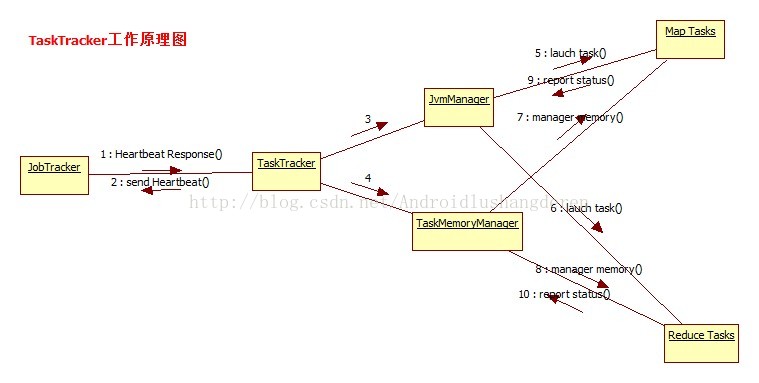上次分析完JobTracker通过TaskScheduler如何把作业分配给TaskTracker,这次把目光 移动到TaskTracker上面。TaskTracker在这里其实是一个slave的从属关系。我在后面的分析会通过TaskTracker的执行流程,主要讲他的2个过程的分析1.作业启动执行2.与JobTracker的heatbeat的过程。2个过程都是非常的典型。
与JobTracker一样,TaskTracker也是作为一项服务所运行的,他也有自己的main函数入口。下面是一张全局的TaskTracker执行过程流程图:
jvmManager负责为每个Task分配一个java虚拟机环境让其执行,避免任务之间的干扰,TaskMemoryManager负责任务内存的监控,对于某些任务恶意消耗资源内存,会给予杀死此任务的处理。
1.TaskTracker任务启动
下面从main函数的入口开始分析一下TaskTracker的执行流程:
/**
* Start the TaskTracker, point toward the indicated JobTracker
* taskTracker同样也是一个服务程序,main函数开始执行
*/
public static void main(String argv[]) throws Exception {
StringUtils.startupShutdownMessage(TaskTracker.class, argv, LOG);
if (argv.length != 0) {
System.out.println("usage: TaskTracker");
System.exit(-1);
}
try {
//初始化作业配置
JobConf conf=new JobConf();
// enable the server to track time spent waiting on locks
ReflectionUtils.setContentionTracing
(conf.getBoolean("tasktracker.contention.tracking", false));
//初始化度量统计系统
DefaultMetricsSystem.initialize("TaskTracker");
//根据作业配置初始化TaskTracker
TaskTracker tt = new TaskTracker(conf);
//注册MBean,方便外界工具检测TaskTracker的状态
MBeans.register("TaskTracker", "TaskTrackerInfo", tt);
//执行TaskTracker服务主程序
tt.run();
} catch (Throwable e) {
LOG.error("Can not start task tracker because "+
StringUtils.stringifyException(e));
System.exit(-1);
}
}/**
* The server retry loop.
* This while-loop attempts to connect to the JobTracker. It only
* loops when the old TaskTracker has gone bad (its state is
* stale somehow) and we need to reinitialize everything.
*/
public void run() {
try {
getUserLogManager().start();
//开启CleanUp清理线程
startCleanupThreads();
boolean denied = false;
while (running && !shuttingDown && !denied) {
boolean staleState = false;
try {
// This while-loop attempts reconnects if we get network errors
while (running && !staleState && !shuttingDown && !denied) {
try {
//offerService()执行了核心的启动操作
State osState = offerService();
if (osState == State.STALE) {
staleState = true;
} else if (osState == State.DENIED) {
denied = true;
}
....../**
* Main service loop. Will stay in this loop forever.
* 主要的循环服务操作
*/
State offerService() throws Exception {
.....
// Send the heartbeat and process the jobtracker's directives
//发送给JobTracker心跳包
HeartbeatResponse heartbeatResponse = transmitHeartBeat(now);
// Note the time when the heartbeat returned, use this to decide when to send the
// next heartbeat
lastHeartbeat = System.currentTimeMillis();
....
//在这里获取了心跳回应中的action命令
TaskTrackerAction[] actions = heartbeatResponse.getActions();
if(LOG.isDebugEnabled()) {
LOG.debug("Got heartbeatResponse from JobTracker with responseId: " +
heartbeatResponse.getResponseId() + " and " +
((actions != null) ? actions.length : 0) + " actions");
}
if (reinitTaskTracker(actions)) {
return State.STALE;
}
// resetting heartbeat interval from the response.
heartbeatInterval = heartbeatResponse.getHeartbeatInterval();
justStarted = false;
justInited = false;
if (actions != null){
for(TaskTrackerAction action: actions) {
if (action instanceof LaunchTaskAction) {
//如果是执行Task任务指令,执行添加任务到任务队列中
addToTaskQueue((LaunchTaskAction)action);
} else if (action instanceof CommitTaskAction) {
//如果是提交任务的指令,则执行后面的操作
CommitTaskAction commitAction = (CommitTaskAction)action;
if (!commitResponses.contains(commitAction.getTaskID())) {
LOG.info("Received commit task action for " +
commitAction.getTaskID());
commitResponses.add(commitAction.getTaskID());
}
} else {
//其他的指令一律添加到tasksToCleanup队列中等待被处理
tasksToCleanup.put(action);
}
}
}
.....
具体什么意思,看上面的英文解释就能理解了吧,上面代表了6种命令操作,我们侧重看第一个launch_task的命令执行,在上面的判断执行方法是addToTaskQueue();方法:
private void addToTaskQueue(LaunchTaskAction action) {
//任务类型加入到任务待执行的容器中
if (action.getTask().isMapTask()) {
mapLauncher.addToTaskQueue(action);
} else {
reduceLauncher.addToTaskQueue(action);
}
}class TaskLauncher extends Thread {
private IntWritable numFreeSlots;
private final int maxSlots;
private List<TaskInProgress> tasksToLaunch;
....public void addToTaskQueue(LaunchTaskAction action) {
//新建1个TIP,并加入tasksToLaunch列表
synchronized (tasksToLaunch) {
TaskInProgress tip = registerTask(action, this);
tasksToLaunch.add(tip);
//唤醒所有被tasksToLaunch wait的操作,说明此时有新的任务了
tasksToLaunch.notifyAll();
}
}public void run() {
while (!Thread.interrupted()) {
try {
TaskInProgress tip;
Task task;
synchronized (tasksToLaunch) {
while (tasksToLaunch.isEmpty()) {
tasksToLaunch.wait();
}
//get the TIP
tip = tasksToLaunch.remove(0);
task = tip.getTask();
LOG.info("Trying to launch : " + tip.getTask().getTaskID() +
" which needs " + task.getNumSlotsRequired() + " slots");
}
//wait for free slots to run
.....
//got a free slot. launch the task
startNewTask(tip);2.Heateat过程
下面我们看另外一个流程,心跳机制。此过程的实现同样的主要是在offerService的循环操作中。首先第一步,判断是否到了发送心跳包的时间,因为心跳包是隔周期性的时间发送的,所以这里必须会进行判读:
/**
* Main service loop. Will stay in this loop forever.
* 主要的循环服务操作
*/
State offerService() throws Exception {
long lastHeartbeat = System.currentTimeMillis();
while (running && !shuttingDown) {
try {
long now = System.currentTimeMillis();
// accelerate to account for multiple finished tasks up-front
//判断上次心跳的时间+心跳等待时间是否已经到了当前时间,如果到了可以发送新的心跳包
long remaining =
(lastHeartbeat + getHeartbeatInterval(finishedCount.get())) - now;
//如果还没到,时间有剩余,则要强行等待剩余的时间
while (remaining > 0) {
// sleeps for the wait time or
// until there are *enough* empty slots to schedule tasks
synchronized (finishedCount) {
finishedCount.wait(remaining);
// Recompute
now = System.currentTimeMillis();
remaining =
(lastHeartbeat + getHeartbeatInterval(finishedCount.get())) - now;
if (remaining <= 0) {
// Reset count
finishedCount.set(0);
break;
}
}
}
..........
// If the TaskTracker is just starting up:
// 1. Verify the buildVersion
// 2. Get the system directory & filesystem
if(justInited) {
//验证版本号,如果版本号不对,则返回拒绝状态
String jobTrackerBV = jobClient.getBuildVersion();
if(!VersionInfo.getBuildVersion().equals(jobTrackerBV)) {
String msg = "Shutting down. Incompatible buildVersion." +
"
JobTracker's: " + jobTrackerBV +
"
TaskTracker's: "+ VersionInfo.getBuildVersion();
LOG.error(msg);
try {
jobClient.reportTaskTrackerError(taskTrackerName, null, msg);
} catch(Exception e ) {
LOG.info("Problem reporting to jobtracker: " + e);
}
return State.DENIED;
}// Send the heartbeat and process the jobtracker's directives
//发送给JobTracker心跳包
HeartbeatResponse heartbeatResponse = transmitHeartBeat(now);里面2大包含类ResourceStatus(TaskTracker资源使用情况),TaskTrackerHealthStatus(TaskTracker节点健康状况)。首先当然是新建一个Status了:
/**
* Build and transmit the heart beat to the JobTracker
* 将TaskTracker自身的状态信息发送给JobTracker,并获得一个心跳包的回应
* @param now current time
* @return false if the tracker was unknown
* @throws IOException
*/
HeartbeatResponse transmitHeartBeat(long now) throws IOException {
....
//
// Check if the last heartbeat got through...
// if so then build the heartbeat information for the JobTracker;
// else resend the previous status information.
//
if (status == null) {
synchronized (this) {
status = new TaskTrackerStatus(taskTrackerName, localHostname,
httpPort,
cloneAndResetRunningTaskStatuses(
sendCounters),
failures,
maxMapSlots,
maxReduceSlots);
}
//
// Check if we should ask for a new Task
// 检测TaskTracker是否需要一个新 Task任务
//
boolean askForNewTask;
long localMinSpaceStart;
synchronized (this) {
//通过判断当前所占据的slots数量是否已经达到最大slot的数量作为标准
askForNewTask =
((status.countOccupiedMapSlots() < maxMapSlots ||
status.countOccupiedReduceSlots() < maxReduceSlots) &&
acceptNewTasks);
localMinSpaceStart = minSpaceStart;
} //
// Xmit the heartbeat
// 通过JobClient发送给JobTracker,并获得1个回复
//
HeartbeatResponse heartbeatResponse = jobClient.heartbeat(status,
justStarted,
justInited,
askForNewTask,
heartbeatResponseId);
总结
2个过程都是在offerService核心服务程序中执行的。了解完JobTracker和TaskTracker的工作原理,在聊了具体Task任务的执行的5个阶段,从微观Task细节的执行到宏观上作业调度的原理分析理解,的确对MapReduce计算模型的理解上升了许多的层次。




